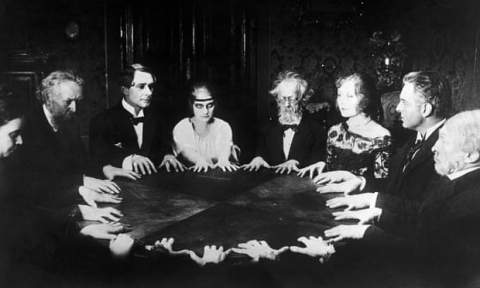When I recently discovered my great-grandmother, Bertha Krech née Sturm, was an early 20th century Spiritualist minister in Rochester, New York, my need to know more was voracious.
What was her church like?
How could a woman rise to ministry before she was even legally allowed to vote?
And, certainly most pressingly, what really is Spiritualism?
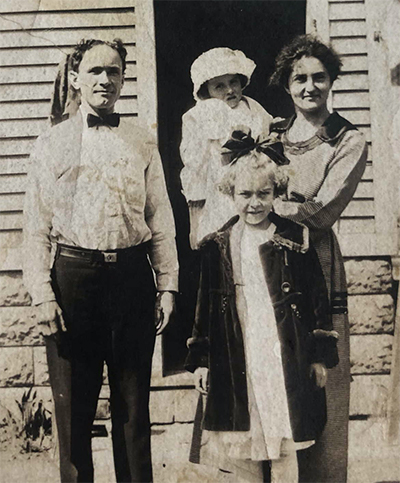
Spiritualist church, and her husband who was often a
speaker at the church and himself a passionate
Spiritualist. Photo, c. 1918. Courtsey of Rikki Schlott-Gibeaux
My great-grandmother's Spiritualist experience
Through newspaper articles and family stories, I pieced together a sketch of her life and her faith. Born in 1880s Rochester, Bertha converted as a young woman from Lutheranism to Spiritualism—a practice based on communication with spirits of the dead through a medium.
She supposedly contacted the “other side” under the guidance of her “spirit guide,” a deceased Native American chief named Hontu.
A fixture of Spiritualist social circles, Bertha gained notoriety for her animated readings, ability to speak in tongues, and apparently intrinsic connection with another dimension. Reportedly her encounters with the dead were so powerful—so taxing on her mind and body—that they would leave her trembling with paralyzing headaches.
At some point in her thirties, my great-grandmother was named head minister at her local congregation, Plymouth Avenue Spiritualist Church.
She preached a progressive and inclusive central philosophy: there was only one God, but He fathered many different faces to accommodate the religion of every person; furthermore, an intrinsic connection to God and the power to communicate with the dead existed in every human soul. She continued to practice and preach Spiritualism until her death in the 1970s.
Although these details put some flesh on the bones of her story, ultimately, I was left with more questions than answers. So, I set out to better understand Spiritualism, its context, and its origins in 19th century New York.
The cultural context of Spiritualism's emergence
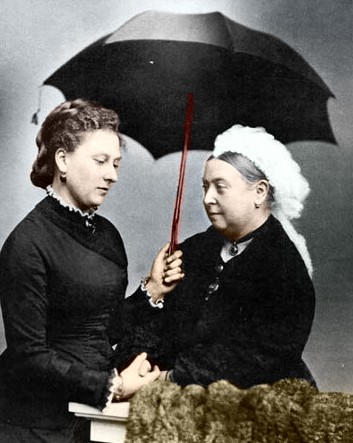
a permanent mourning period after her husband
Albert's passing. Image via Wikimedia Commons.
Spiritualism was the true antithesis of the social climate it erupted out of. Death was a very real and very prevalent aspect of life, particularly for a nineteenth century woman.
Queen Victoria, pictured right, provides a well-known example. She adopted an essentially permanent mourning period which she assumed upon her husband Albert’s passing. She would wear only black for the remaining forty years of her life.
Regarded as “the moral emblem of the era,” Queen Victoria’s very public mourning led to mainstream emulation.1 A certain fashionableness was lent to the mourning process, spawning a mainstream consumer demand for specific styles and goods.
Women everywhere dealt with death—without access to hospitals or undertakers, death occurred in the home, and therefore within the woman’s sphere. Of 1853’s deaths in New York, forty-nine percent were children under five and predominantly under maternal care.2
Confrontation of death and care for the ill were naturally part of the social contract of womanhood. Expectations of women, particularly widows, in the wake of death became all-consuming: “Women [were] expected to focus their lives on the future of family members during life [and] also expected to feel the losses through death more deeply than men, [even adopting] permanent mourning as a full-time occupation.”3
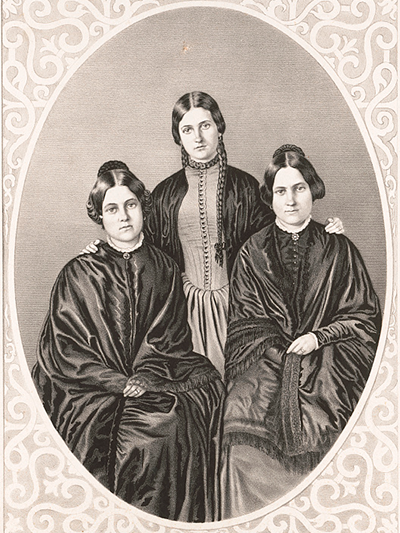
Library of Congress
The Fox sisters' paranormal experience
It was out of this era of rigidity that Spiritualism erupted.
Its foundations lie upon the paranormal experiences of three sisters from Hydesville, New York. The Spiritualist messiahs were eleven-year-old Kate, fourteen-year-old Maggie, and eldest sister Leah Fox.
In 1848, Maggie and Kate reported a “rapping” on their bedroom walls. When sounds escalated to inexplicable slams and thuds, the girls insisted they were of ghostly origin. They invited neighbors, and soon up to fifteen at a time would crowd into the bedroom to witness the spectral racket.4
Ciphered bumps and thuds supposedly enabled communication with the spirit of Charles B. Rosna.
Locals confirmed that Rosna, a traveling salesman, had indeed been killed in that very bedroom five years earlier. He would answer yes or no questions and dazzle any onlooker beyond any reasonable doubt.
Rumors circulated, witnesses lined up at the Fox home, and soon the area was taken with a fervor for contacting the hereafter.5 And, so, Spiritualism was born—a new religion founded solely on the word of three very young women and their supernatural spectacle.
Spiritualism takes root in Western New York
Luckily the Fox Sisters made their home in the infamous Burned-over District.
Western New York was “well known in the early nineteenth century for its receptiveness toward emotional exaltation… [there existing the proper environment for the development of reforms that ranged from abolition to feminism, from hydropathy to Spiritualism.”6
Economic distress and generalized social weariness rendered the region historically susceptible to novel movements like Spiritualism and Mormonism spreading like wildfire. By the Fox sisters’ time, the religion was buzzing with radical views on feminism, abolition, and more.
Spiritualism proved popular among these progressive circles—and particularly among women.
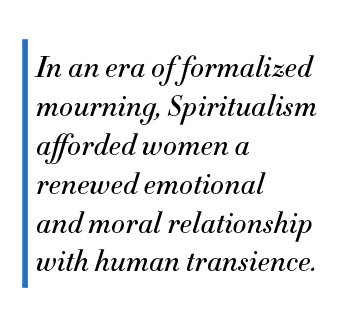 In an era of formalized mourning, Spiritualism afforded women a renewed emotional and moral relationship with human transience. Spiritualism “provided a way to sow love and interest in the dead without submitting to restrictions on one’s activities that accompanied mourning.”7
In an era of formalized mourning, Spiritualism afforded women a renewed emotional and moral relationship with human transience. Spiritualism “provided a way to sow love and interest in the dead without submitting to restrictions on one’s activities that accompanied mourning.”7
Spiritualism and women's rights
The Spiritualist bug quickly spread into similar forward-thinking groups, and soon many famous progressives of the area began attending séances and Spiritualist services, among them the Beecher family, William Lloyd Garrison, and the Grimké sisters. And so a pattern arose: “Consistently those who assumed the most radical positions on woman’s rights became Spiritualists.”8 Spiritualism and progressivism then bled together.
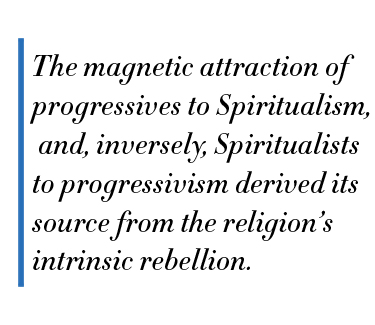 Spiritualists championed endless progressive causes—abolition of slavery, reform of marriage, children’s rights, dress reform, religious freedom, socialism, labor reform, vegetarianism, temperance, and anti-sabbatarianism to name a few.9
Spiritualists championed endless progressive causes—abolition of slavery, reform of marriage, children’s rights, dress reform, religious freedom, socialism, labor reform, vegetarianism, temperance, and anti-sabbatarianism to name a few.9
The magnetic attraction of progressives to Spiritualism, and, inversely, Spiritualists to progressivism derived its source from the religion’s intrinsic rebellion: through its inception in Hydesville a rebellion against oppression, through its ideology a rebellion against convention, and through the séance a rebellion against death itself.
Breaking virtually all ecclesiastical custom, Spiritualism manifested a sort of religious anarchism that harmonized with the agendas of progressive disruptors, many of them outspoken women.
Female leadership in Spiritualism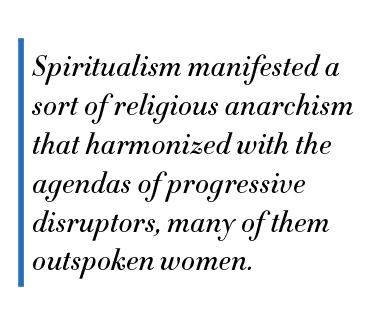
In an era when women were often forbidden from speaking in traditional churches, they were nonetheless as prevalent as men among Spiritualist leadership. In their History of Woman Suffrage, Elizabeth Cady Stanton and Susan B. Anthony celebrated Spiritualism as “the only religious sect in the world… that has recognized the equality of woman. Spiritualists have always assumed that woman may be a medium of communication from heaven to earth…that the spirits of the universe may breathe through her lips.”10
In fact, Spiritualists “imagined heaven as an extension of woman’s sphere.”11 As most individuals crossed into the hereafter within the confines of the home—woman’s dominion—it only seemed natural to Spiritualists that heaven embodied similar characteristics.
Bertha’s leadership as a young woman was not entirely unique. Female lecturers as young as pre-teens frequently drew crowds of thousands. A good medium required a certain womanly sensitivity and intuition, and thus lecturers were overwhelmingly female.
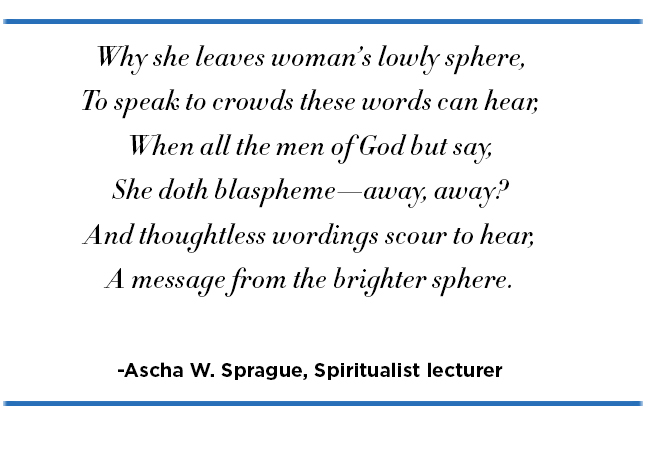
Indeed, researchers have found that women tend to rise to leadership positions “where religious authority derives from direct individual spiritual contact or experience rather than from office, position, or training.12
For its time, Spiritualism was a uniquely meritocratic religion. From its very inception, the Fox sisters proved that the portal to the beyond existed in every soul.
Vested in each individual, according to Spiritualists, was a holy psychic gift. In order to access it, one needed only to try. To sit at the séance table was to personally demand answers and take a dynamic role in one’s own faith. Therefore, spiritualism privileged female voices.
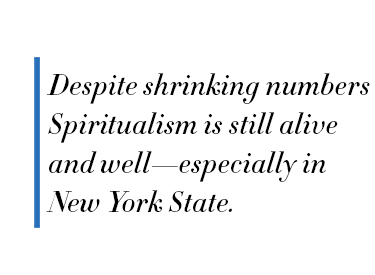 The decline of Spiritualism
The decline of Spiritualism
There was a time when Spiritualism seemed omnipresent; prominent figures from Arthur Conan Doyle to Mary Todd Lincoln were unabashed practitioners.
When the Fox Sisters admitted that their spectacle had been a hoax, however, numbers dropped sharply. This trend has continued ever since.
Despite shrinking numbers, Spiritualism is still alive and well—especially in New York State. Although displaced from their original location, my great-grandmother's congregation remains active. And, just one hundred miles west, is the lakeside community of Lily Dale, New York—a Spiritualist Mecca of sorts, and a favorite destination of Bertha’s.
Lily Dale: New York’s home for mediumship and spiritual healing
The community of Lily Dale was established in the late 19th century as a meeting place and camp for Spiritualists and Freethinkers.
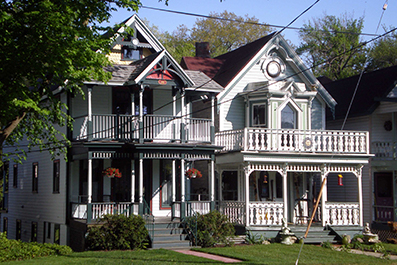
Those on society’s religious fringes flocked to Lily Dale in the pursuit of alternative education, readings, and, perhaps most importantly, like-minded individuals.
The community boasted four churches, many outdoor centers of worship, and large halls for gatherings—even the Fox Sisters’ home was relocated to the grounds. Bertha was among the many who made annual pilgrimages to the site to attend lectures and mingle within the community.13
Though unbeknown to most, Lily Dale continues to thrive to this day. According to the local assembly, the community is “New York’s home for mediumship and spiritual healing since 1879”.
The quaint, flowery streets of Lily Dale are lined with colorful Victorian homes. Almost every one has a sign out front advertising services in mediumship, healings, and readings. In fact, in order to live in the gated community of Lily Dale, one must be a professional registered medium through the Spiritualist Church.14
Despite only fifty year round medium residents, Lily Dale is the world’s largest Spiritualist community, and it attracts an excess of 20,000 visitors annually. With guest houses, bookstores, and even a café, the odd yet charming community—“not for being flashy or grand”—offers visitors meditations, healings, messages, and church services on a daily basis.
Despite a sharp decline in popularity since its heyday, Spiritualism is still very much vibrant and alive in Lily Dale. Teeming with oddity and charm, this little-known community is a true living relic of New York’s religious past. Though oft-forgotten, Spiritualism indeed shaped the intellectual and religious landscape of its era. It truly epitomized the fervor, intensity, and eccentricity of New York’s Burned Over District. And, though perhaps a bit spooky, I will forever be captivated by the story of my great-grandmother—champion of her beliefs, leader of faith, rebel against convention, and a remarkable character who truly lived and breathed Spiritualism.
Citations
1. Braude, Ann. Radical Spirits Spiritualism and Womens Rights in Nineteenth-Century America. Indiana University Press, 2013. 53 | ^Back to text
2. Ibid. | ^Back to text
3. Ibid. | ^Back to text
4. The Occult Museum. “Speaking with Spirits: The Fox Sisters and the Birth of Spiritualism.” The Occult Museum, 16 May 2017, www.theoccultmuseum.com/ speaking-spirits-fox-sisters-birth-spiritualism | ^Back to text
5. Ibid. | ^Back to text
6. Riegel, Robert E., et al. “‘WOMAN'S RIGHTS AND OTHER 'REFORMS' IN SENECA FALLS:" A CONTEMPORARY VIEW.” New York History, vol. 46, no. 1, 1965, pp. 41– 59. JSTOR, www.jstor.org/stable/23162465. 41 | ^Back to text
7. Braude, 53 | ^Back to text
8. Braude, 59 | ^Back to text
9. Braude, 3 | ^Back to text
10. Ibid. | ^Back to text
11. Braude, 52. | ^Back to text
12. Braude, 6. | ^Back to text
13. Lily Dale Assembly. “Lily Dale.” Lily Dale Aasembly, https://www.lilydaleassembly.org | ^Back to text
14. Ibid. | ^Back to text
